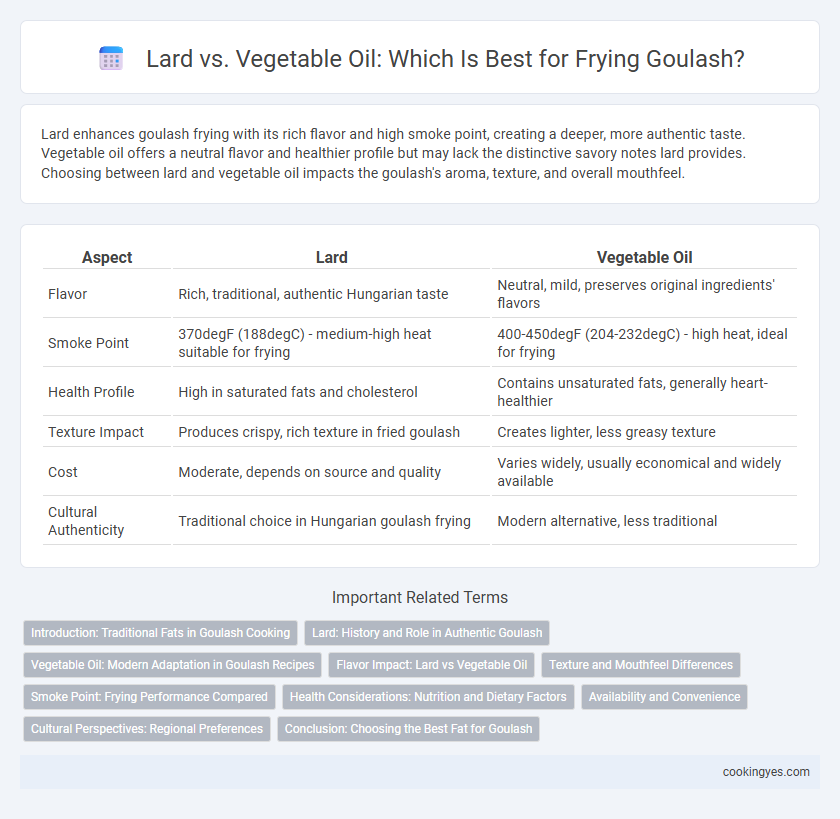Lard enhances goulash frying with its rich flavor and high smoke point, creating a deeper, more authentic taste. Vegetable oil offers a neutral flavor and healthier profile but may lack the distinctive savory notes lard provides. Choosing between lard and vegetable oil impacts the goulash's aroma, texture, and overall mouthfeel.
Table of Comparison
| Aspect | Lard | Vegetable Oil |
|---|---|---|
| Flavor | Rich, traditional, authentic Hungarian taste | Neutral, mild, preserves original ingredients' flavors |
| Smoke Point | 370degF (188degC) - medium-high heat suitable for frying | 400-450degF (204-232degC) - high heat, ideal for frying |
| Health Profile | High in saturated fats and cholesterol | Contains unsaturated fats, generally heart-healthier |
| Texture Impact | Produces crispy, rich texture in fried goulash | Creates lighter, less greasy texture |
| Cost | Moderate, depends on source and quality | Varies widely, usually economical and widely available |
| Cultural Authenticity | Traditional choice in Hungarian goulash frying | Modern alternative, less traditional |
Introduction: Traditional Fats in Goulash Cooking
Lard has been the traditional fat for frying goulash, valued for its rich flavor and ability to enhance the dish's authenticity in Hungarian cuisine. Vegetable oil offers a neutral taste and higher smoke point, providing a lighter alternative that maintains the tenderness of the meat. Choosing between lard and vegetable oil impacts the overall aroma and texture, influencing the classic goulash experience.
Lard: History and Role in Authentic Goulash
Lard has been a cornerstone in traditional Hungarian goulash recipes, prized for its ability to impart rich, savory depth and enhance the paprika's flavor. Historically, lard was the preferred cooking fat due to its availability in rural Hungary, contributing to the dish's authentic texture and mouthfeel. Unlike vegetable oils, lard's natural animal fats create a more robust aroma and a fuller-bodied taste essential to classic goulash preparation.
Vegetable Oil: Modern Adaptation in Goulash Recipes
Vegetable oil has become a popular modern adaptation in goulash recipes due to its neutral flavor and higher smoke point, which prevents burning during frying. Its use maintains the authenticity of Hungarian goulash while offering a lighter alternative to traditional lard. Chefs prefer vegetable oil for its versatility and consistency, enhancing the stew's rich paprika-infused base without overwhelming other flavors.
Flavor Impact: Lard vs Vegetable Oil
Lard imparts a rich, savory depth and traditional authenticity to goulash, enhancing the meat's natural flavors with its slightly smoky, buttery notes. Vegetable oil provides a neutral base, allowing the spices and paprika to shine without adding competing flavors. Choosing lard over vegetable oil intensifies the overall richness and mouthfeel, creating a more robust and flavorful goulash experience.
Texture and Mouthfeel Differences
Lard imparts a rich, silky texture and enhances the mouthfeel of goulash with its natural fat content, creating a smooth, velvety coating on meat and vegetables. Vegetable oil tends to produce a lighter, less dense texture, allowing the individual flavors to remain more distinct but offering less depth in richness. The choice between lard and vegetable oil directly influences the goulash's savory robustness and the overall tactile sensation in every bite.
Smoke Point: Frying Performance Compared
Lard, with a smoke point around 374degF (190degC), offers a rich flavor ideal for traditional goulash frying, maintaining stability under medium-high heat without burning quickly. Vegetable oils like canola or sunflower have higher smoke points, approximately 400degF to 450degF (204degC to 232degC), providing better heat tolerance and reduced risk of smoke during prolonged frying. Choosing between lard and vegetable oil depends on balancing authentic taste versus higher smoke point and cleaner frying performance.
Health Considerations: Nutrition and Dietary Factors
Lard offers a rich source of monounsaturated fats and fat-soluble vitamins like vitamin D, but it is high in saturated fats, which may impact cardiovascular health if consumed excessively. Vegetable oils, such as sunflower or canola oil, provide healthier unsaturated fats and essential omega-3 fatty acids, supporting heart health and reducing inflammation. Choosing vegetable oil for frying goulash aligns better with dietary guidelines favoring unsaturated fats and lower cholesterol intake for optimal nutrition.
Availability and Convenience
Lard, a traditional cooking fat for goulash, may be less readily available in some markets compared to vegetable oil, which is widely stocked and easier to find in most grocery stores. Vegetable oil offers convenience due to its longer shelf life and neutral flavor, allowing cooks to fry goulash without altering the authentic taste significantly. Selecting between lard and vegetable oil depends on access and ease, with vegetable oil often favored for consistent availability and hassle-free use.
Cultural Perspectives: Regional Preferences
In Central European regions like Hungary and Austria, lard is traditionally preferred for frying goulash due to its rich flavor and cultural authenticity. In contrast, Western European and North American adaptations often favor vegetable oil for a lighter taste and health-conscious appeal. Regional preferences influence not only the cooking fat but also the overall flavor profile and texture of the goulash dish.
Conclusion: Choosing the Best Fat for Goulash
Lard enhances goulash with rich, authentic flavor and high smoke point, making it ideal for frying traditional Hungarian stew ingredients. Vegetable oil offers a neutral taste and is often preferred for a lighter, more subtle dish, while also being suitable for high-heat cooking. Opting between lard and vegetable oil depends on whether you prioritize classic taste depth or a cleaner, more versatile frying medium.
Lard vs vegetable oil for goulash frying Infographic

 cookingyes.com
cookingyes.com